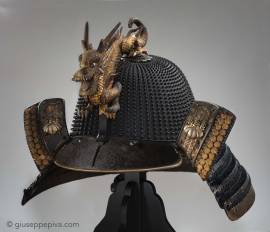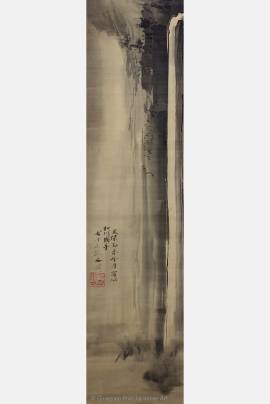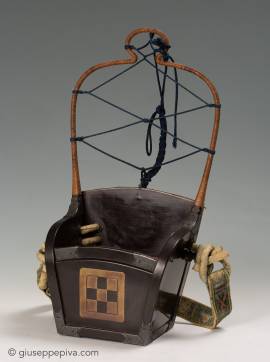A russet iron samurai helmet with small standing rivetsEdo period, 17th-18th centurySigned: Saotome Iechika A russet iron (tetsu sabiji) sixty-two plate kabuto, each mounted with twenty-five small tapered standing rivets (ko-boshi) of decreasing size; the front plate, larger than the others, is fitted with two lines of rivets, while the rear one is left empty, for a total of 1.550 rivets.The typical "Saotome-byo" is visible under this lining, an extra rivet which is almost an additional signature of the Saotome armorers.The five-stage shikoro (neck protection) is in blue-laced...
WORKS FOR SALE
Tani Buncho (1763-1840)Waterfall in kagawa, 1835Hanging scroll; ink on silkPainting: 164 by 40 cmMounts: 233x60 cm. Ivory jikusaki.Signed with the artist’s seals and titled:Painted in the winter of the sixth year of the Tenpou Era (1835)Does this not recall Kagawa-no-kuni?73-year-old man, Buncho Natural landscapes became an archetypal subject in Asian art since Chinese Song dynasty (10th Century) and waterfalls have always been an important presence in East Asian and Japanese paintings. Many Japanese artists portrayed waterfalls using different styles, especially during...
EbiraSamurai open quiverMid Edo period, 17th-18th centuryHeight: 35 cm This black lacquered antique ebira is decorated on the front side with a gold lacquer family crest (kamon) with ishidatami (paving stone) design. High quality level engraved metal kanamono have been applied to decorate and protect all corners and borders.The back side is covered with stenciled dear skin and a belt made of same leather is tied to the sides.On this page is a comprehensive glossary of common terms related to samurai armor.Ebira for sale. Price on application. Please include item stock number:...
Copyright © 2016 - giuseppe piva - VAT: 05104180962










